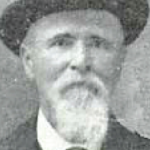
HARRISBURG: JULY 13, 1864- General Stephen Dill Lee’s corps and division commanders had a consultation on the night of July 12th. Brigadier General Abraham Buford informed the council that he observed: “(General Andrew Jackson Smith’s) force was admirably equipped, commanded by an officer of experience and skill…moved with great caution, always prepared…I had discovered no evidence of the demoralized condition of the enemy, but had found him ever ready for action.”
Historian Ed Bearss noted: “The confusion caused by the sudden change in Confederate battle plans on the night of July 12 aided Federal movements on the 13th. The withdrawal of Colonel E.W. Rucker’s Brigade (including Tipton’s men in the 7th Tennessee) and the 2nd Tennessee had left the Pontotoc – Tupelo Road practically unguarded at a critical period.” At dawn Smith’s Federals began the march east toward Tupelo. The cavalry led the advance followed by the infantry; the 61st U. S. Colored Infantry and the 7th Kansas Cavalry bringing up the rear.
From his position in front of Pinson’s Hills, Colonel Hinchie P. Mabry’s Mississippians probed the enemy position early on the 13th. Mabry learned the Federals were pulling back and at 6 a.m. reported this to General Buford. Mabry advanced his men cautiously encountering the 61st U. S. Colored Infantry. Generals’ Lee and Forrest arrived at this time and discovered the Federal birds had flown the coup and moving rapidly toward Tupelo. The 6th Mississippi Cavalry under Colonel Isham Harrison arrived at this time and joined Mabry’s force.
Lee directed Major General N. B. Forrest with his Escort and McDonald’s Tennessee Battalion, Mabry’s Brigade and the Pettus Artillery “to attack, and press upon the rear of the enemy.” General Chalmers noted the Federals were ten miles east of Pontotoc when he received orders to “attack them vigorously in flank.” Chalmers and Colonel E. W. Rucker’s Brigade set out on the parallel Verona Road to attack the Federal column in flank. Buford’s Division and General Lee followed on the same road in an attempt to head off and assail the head of the enemy column.
The 14,000 Federals faced only Captain H. A. Tyler’s 100-man detachment of the 12th Kentucky Cavalry. Following a half an hour skirmish, the Kentuckians were pushed aside by the 3rd Iowa but maintained a running fight for 12 miles until veering off to the southeast on the Verona Road.
Historian Thomas Parson noted the past three days of marching and countermarching had worn out the Confederate horses and wearied the men.” Forrest’s command came upon the Federal rear a mile out from Pontotoc on the Okolona Road about 7 a.m. Forrest ordered Mabry to force his way into Pontotoc. “Attacking with their characteristic abandon, Mabry’s Mississippians, supported by Forrest’s Regiment and escort company, brushed aside the 7th Kansas Cavalry and Company A., 61st Colored Infantry,” chasing them through town and out on the Tupelo Road.
The Federal rear guard was several miles east of Pontotoc when a messenger from the 7th Kansas informed them Confederates were fast approaching. Colonel Edward Bouton, commanding the Colored Brigade (including a few post-war residents of Tipton) ordered Colonel F. A. Kendrick, 61st Infantry to set an ambush. Two companies were deployed into the underbrush beside the road just as the company of Colored soldiers and Kansans hurried by. As the Confederates got to within a few paces of the ambush, the Federals “cut loose a well-aimed volley that emptied a score of saddles and threw the pursuing column into confusion.” Disengaging rapidly the Yanks moved a mile down the road where they formed another ambush.
Continued.




